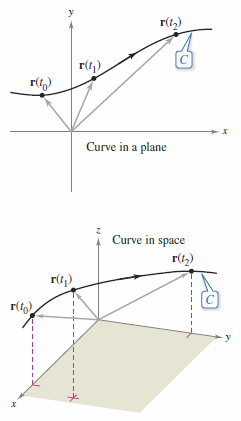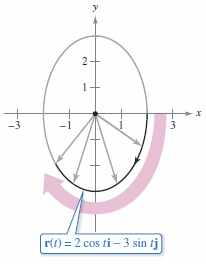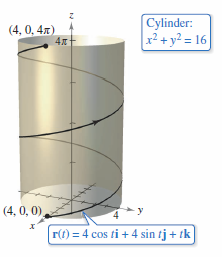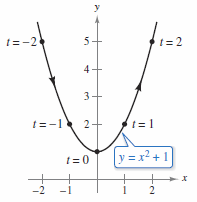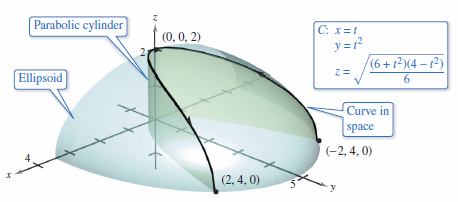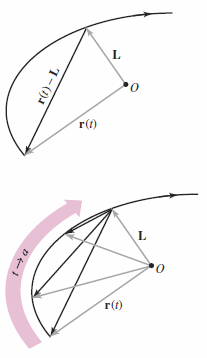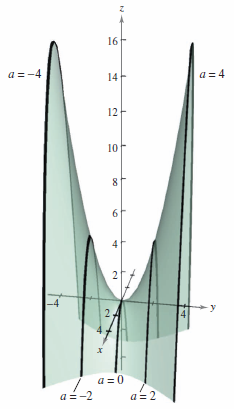Calculus III 12.01 Vector-Valued Functions
| Previous | Calculus III 11 Vectors and Spacial Geometry |
| Next | Calculus III 12.02 Differentiation and Integration for Vector-Valued Functions |
Contents
12.1 Vector-Valued Functions
- Analyze and sketch a three dimensional curve given by a vector-valued function.
- Extend limits and continuity to vector-valued functions.
Three Dimensional Curves and Vector-Valued Functions
In Section 10.2 a plane curve is defined as two ordered pairs, \((f(t),g(t))\), together with their defining parametric equations
- \(x=f(t) \text{, and } y=g(t)\)
where \(f\) and \(g\) are continuous functions for \(t\) on an interval \(I\). This definition can be extended to three dimensions with three ordered pairs, \((f(t),g(t),h(t))\), together with their defining parametric equations
- \(x=f(t) \text{, } y=g(t) \text{, and } z=h(t)\)
where \(f\), \(g\), and \(h\) are continuous functions for \(t\) on an interval \(I\).
Describing three dimensional curves requires a new function, called a vector-valued function which maps real numbers to vectors.
Definition 12.1.1 Vector-Valued Functions
A function with the form
- \( \textbf{r}(t)=f(t)\textbf{i}+g(t)\textbf{j}\:\:\:\:\)Two-Dimensions
or
- \( \textbf{r}(t)=f(t)\textbf{i}+g(t)\textbf{j}+h(t)\textbf{k}\:\:\:\:\)Three-Dimensions
is a vector-valued function, where the component functions where \(f\), \(g\), and \(h\) are real-valued functions for the parameter \(t\). Vector-valued functions are sometimes denoted as
- \( \textbf{r}(t)= \langle f(t),g(t)\rangle\:\:\:\:\)Two-Dimensions
or
- \( \textbf{r}(t)= \langle f(t),g(t),h(t)\rangle.\:\:\:\:\)Three-Dimensions
Where \( \textbf{r}(t)\) is a vector and the functions, \(f\), \(g\), and \(h\), produce real numbers for any \(t\).
|
|
Technically, a curve is described by the points along it and the defining parametric equations. Two different curves can have the same graph. For instance, the following curves
and
have the unit circle for their graph. But the curves are traced differently. Vector-valued functions serve dual roles in describing curves. By letting the parameter \(t\) represent time, the vector-valued function can describe motion along a curve. In the more general case, the vector-valued function can trace the curve's graph. In both cases the terminal point for the position vector \(\textbf{r}(t)\) coincides with the point \((x,y)\) or \((x,y,z)\) on the curve given by the parametric equations, as shown in Figure 12.1.1. The arrowhead on the curve indicates the curve’s orientation by pointing in the direction where \(t\) increases in value. Unless stated otherwise, the domain for a vector-valued function is where the domains for the component functions \(f\), \(g\), and \(h\) intersect. For instance, the domain for \(\textbf{r}(t)=\ln t \textbf{i} + \sqrt{1-t}\textbf{j}+t\textbf{k}\) is the interval \((0,1]\). |
Example 12.1.1 Sketching a Two-Dimensional Curve
|
|
Sketch the plane curve represented by the vector-valued function
Solution The vector \( \textbf{r}(t)\) yields the parametric equations
Solving for \( \cos t \) and \( \sin t \) and using the identity \(\cos^{2}t+\sin^{2}t=1\) produces the cartesian equation
The resulting clockwise ellipse is shown in Figure 12.1.2. By clockwise means as \(t\) increases from 0 to \(2\pi\), the position vector \(r(t)\) moves clockwise, and its terminal point traces the ellipse. |
Example 12.1.2 Sketching a Three-Dimensional Curve
|
|
Sketch the three-dimensional curve represented by the vector-valued function
Solution The first two parametric equations
yield
The curve lies on a right cylinder with radius 4, centered about the \(z\)-axis. Use the third parametric equation
to locate the curve on the cylinder, as shown in Figure 12.1.3. As \(t\) increases from 0 to \(4\pi\) the point \((x,y,z)\) spirals up the cylinder to produce a single helix. |
Example 12.1.3 Describe a Two-Dimensional Graph as a Vector-Valued Function
|
|
Describe the parabola
as, shown in Figure 12.1.4, as a vector-valued function.
Note in Figure 12.1.4 the graph is traced from left to right. Had \(x=-t\) been chosen, the curve would have traced from right to left. |
Example 12.1.4 Describe a Three-Dimensional Graph as a Vector-Valued Function
Sketch the three-dimentional curve \(C\) described by the semi-ellipsoid
- $$ \frac{x^{2}}{12}+\frac{y^{2}}{24}+\frac{z^{2}}{4}=1, \:\: z \geqslant 0 $$
intersecting the parabolic cylinder \(y=x^{2}\), as shown in Figure 12.1.5. Then find a vector-valued function that describes the graph.
Solution The simplest choice for a parameter is to let \(x=t\) from the semi-ellipsoid equation. Applying this to the cylinder equation produces
- \( y=x^{2} \rightarrow y=t^{2}. \)
Solving for \(z\) produces
- $$ \frac{z^{2}}{4} = 1 -\frac{x^{2}}{12}-\frac{y^{2}}{24}=1 -\frac{t^{2}}{12}-\frac{t^{4}}{24}= \frac{24-2t^{2}-t^{4}}{24}=\frac{(6+t^{2})(4-t^{2})}{24}. $$
Because the curve lies above the \(xy\)-plane a positive square root for \(z\) can be chosen to produce the parametric equation
- $$x=t, \: y=t^{2} \text{, and } z = \sqrt{\frac{(6+t^{2})(4-t^{2})}{6} }.$$
The resulting vector-valued function is
- $$\textbf{r}(t)= t\textbf{i}+t^{2}\textbf{j}+ \sqrt{\frac{(6+t^{2})(4-t^{2})}{6} }\textbf{k}, \: -2 \leqslant t \leqslant 2.\:\:\:\:\color{red}{ \text{ Vector-valued function }}$$
Note the \( \textbf{k} \) component restricts the range to \( -2 \leqslant t \leqslant 2 \). The curve starts at (-2,4,0) and traces to (2,4,0) as \(t\) increases from -2 to 2, as shown in Figure 12.1.5.
Limits and Continuity
Vector-valued and real-valued functions share many algebraic properties. For example, vector-valued functions can be added, subtracted, multiplied by a scalar, differentiated, and have a limit just as real-valued functions do. This is done by extending the definitions on a component-by-component basis.
| \( \textbf{r}_{1}(t) + \textbf{r}_{2}(t) \) | \(= \left[ f_{1}(t)\textbf{i} + g_{1}(t)\textbf{j}\right] + \left[ f_{2}(t)\textbf{i} + g_{2}(t)\textbf{j}\right] \:\:\:\: \) | Sum |
| \(= \left[ f_{1}(t) + f_{2}(t) \right]\textbf{i} + \left[ g_{1}(t) + g_{2}(t)\right]\textbf{j} \) | ||
| \( \textbf{r}_{1}(t) - \textbf{r}_{2}(t) \) | \(= \left[ f_{1}(t)\textbf{i} + g_{1}(t)\textbf{j}\right] - \left[ f_{2}(t)\textbf{i} + g_{2}(t)\textbf{j}\right] \:\:\:\:\) | Difference |
| \(= \left[ f_{1}(t) - f_{2}(t) \right]\textbf{i} + \left[ g_{1}(t) - g_{2}(t)\right]\textbf{j} \) | ||
| \( c\textbf{r}(t) \) | \(= c\left[ f_{1}(t)\textbf{i} + g_{1}(t)\textbf{j}\right] \:\:\:\:\) | Scalar Multiplication and Distribution |
| \(= c f_{1}(t)\textbf{i} - cg_{1}(t) \textbf{j} \) | ||
| $$ \frac{ \textbf{r}(t)}{c} $$ | $$= \frac{ \left[ f_{1}(t)\textbf{i} + g_{1}(t)\textbf{j}\right]}{c}, \: c \ne 0 \:\:\:\: $$ | Scalar Division |
| $$= \frac{ f_{1}(t)}{c}\textbf{i} + \frac{g_{1}(t)}{c} \textbf{j} $$ |
Definition 12.1.2 Limit for a Vector-Valued Function
|
|
1. If \( \textbf{r} \) is a vector-valued function such that \( \textbf{r}(t) = f(t)\textbf{i}+g(t)\textbf{j} \), then
2. If \( \textbf{r} \) is a vector-valued function such that \( \textbf{r}(t) = f(t)\textbf{i}+g(t)\textbf{j}+h(t)\textbf{k} \), then
If \( \textbf{r}(t) \) approaches the vector \( \textbf{L} \) as \( t \rightarrow a \), then the vector has the length \( \textbf{r}(t) - \textbf{L}\) approaches 0. Described as an equation
as shown in Figure 12.1.6. |
Definition 12.1.3 Continuity for a Vector-Valued Function with a Limit
A vector-valued function \( \textbf{r} \) is continuous at the point given by \(t=a\) when the limit for \( \textbf{r}(t) \) exists as \(t \rightarrow a \) and
- $$ \lim_{t \rightarrow a} \textbf{r}(t) = \textbf{r}(a).$$
A vector-valued function \( \textbf{r} \) is continuous on an interval \(I\) when it is continuous at every point in the interval. The vector-valued function is continuous at \(t=a\) if and only if each component function is continuous at \(t=a\).
Example 12.1.5 Limit Continuity for a Vector-Valued Function
|
|
Discuss the limit continuity for the vector-valued function
at \(t=0\) where \(a\) is a constant.
Substituting \(t=0\) into the original equation produces
which proves that \(\textbf{r} \) is continuous at \(t=0\). By extension the vector-valued function \(\textbf{r} \) is continuous for all real-number values for \(t\). This produces the saddle-shaped curve, shown in Figure 12.1.7. Each value for \(a\) can be viewed as a hyperbolic paraboloid
intersecting the vertical plane \(y=a\). |
Example 12.1.6 Continuity Intervals for a Vector-Valued Function
Determine the interval(s) on which the vector-valued function
- \( \textbf{r}(t) = t\textbf{i} + \sqrt{ t+ 1 }\textbf{j} + (t^{2} + 1)\textbf{k} \)
is continuous.
Solution The component functions are \(f(t)=t\), \(g(t)=\sqrt{ t+ 1 }\), and \(h(t)=(t^{2} + 1)\). Both \(f\) and \(h\) are continuous for all real-number values for \(t\). The function \(g\) is continuous only for \( t \geqslant -1\). Therefore \( \textbf{r} \) is continuous on the interval \([-1, \infty )\).
Internal Links
Parent Article: Calculus III 12 Vector-Valued Functions
